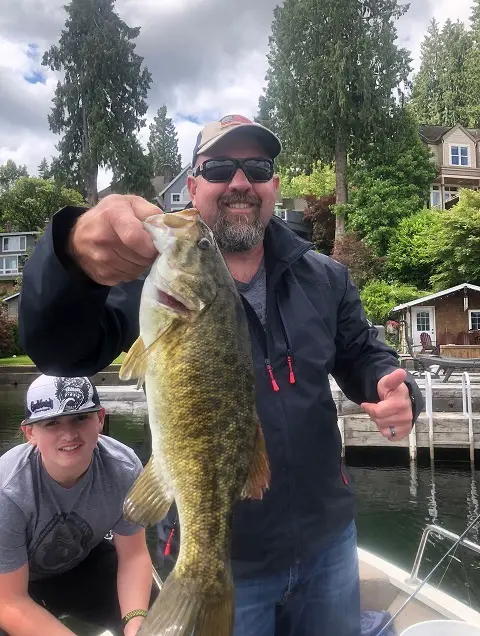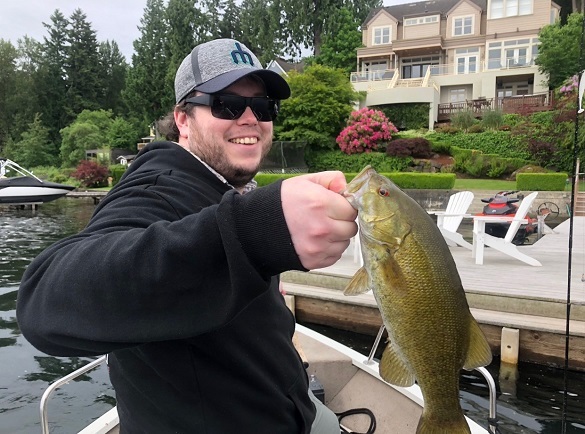Search
Latest Articles
5 Go-To Bedding Bass Baits
by Paul Lewis, April 11, 2021
Bass guarding beds are much more in protection mode than feeding mode, so an angler’s focus is primarily on presenting an irritant, or an invader into their spawning ground. Because of this, I focus on slower presentations and maximizing the amount of time my bait is “invading” or disturbing the spawning area of the fish. So, keeping in mind that this is a great time for slower presentations, here are my 5 go-to spawning bass baits:
5. CREATURE BAITS
Creature baits are a cornerstone in bass fishing year-round, but in the spawn, they can be especially deadly. I am partial to crawfish imitators such as the “Rage Bug” by Strike King or the “Bandito Bug” by Googan Baits, and usually fish a green, pumpkin, or purple/blue color, keeping it to 3.5-4 inches. Creature baits are incredibly versatile and can be modified quite easily by pinching off on of the claws or a piece of the tail to create a streamlined or less flashy approach depending on the situation. Usually, I fish these paired with a pegged 1/8-1/4 oz bullet weight right at the head of the lure giving it a great headfirst sinking action and keeping the end of the bait raised in the air for the bass to grab when the lure is sitting on the bottom or resting in the bed. This bait on the spawn is deadly with twitch-twitch-pause, or a slow lift and pause action. Work this around the bed nice and slow and keep an eye on the fish you are targeting. The action of the fish will tell you how to adapt your presentation.
4. JIGS
Jigs in the spawn work along the same lines as the creature bait, as they have a heavy front end and allow the hook to sit raised off bottom. All sorts of jigs work fantastically around beds from standard jigs, to football head jigs, to even a bladed jig (chatter bait). Many times, I’ll come behind my original presentation on a bed with a jig, especially if I see a bass that is not fazed by a more finesse approach or if I am in dirty water conditions. Jigs are great at kicking up dirt, so when you’re twitching it along bottom, it creates a big dirt plume to really anger the bass protecting the bed. In some cases, switching from the twitch-pause retrieve to literally dragging it along bottom to really kick up dirt (again, especially in murky water). One thing I always do on my jigs is have a trailer on the hook, such as a Bandito Big or Keitech swimbait. Usually, ill match the jig color to the trailer, but sometimes switching it up to a contrasting color or tossing something with a vibrant tail such as chartreuse is a great idea.
3. THE TUBE
Tube baits are deadly on all fish, but smallmouth have a particular fondness towards them. With their slim design and crazy unpredictable legs, tubes pack a lot of action into a little presentation, which is perfect for slower fishing techniques. My go-to tube colors are dark greens with flake (glitter) or white. Tubes are ideal for smaller bass on beds as well as fish that are more skittish when presented with something like a jig or large creature bait. They are not intrusive, and when fished correctly you can just sneak them right onto the strike zone around the bed by casting beyond and working it right in front of the bass’s nose. One technique for tubes I use often is keeping them suspended in the water column as much as possible by doing a slow retrieve with continuous light (light!) twitching to make tail really dance, or by sneaking up on a bed and using a longer rod to keep it off the bottom. One thing to keep in mind when sneaking on a bed is where the sun is located, as it is imperative to avoid your shadow being detected when fishing this way.
2. THE DROP SHOT
This is the ultimate in finesse fishing tactic. Small presentation continuously suspended off the bottom, slender profile, and absolutely deadly! The drop shot is so incredible because it will simultaneously hammer large fish as well as the smaller first-time spawners. If numbers when bed fishing is your goal, this is where it’s at! This rig is comprised with a weight on bottom (usually 1/8 t0 3/16 for me) and a light-wire drop-shot hook (size 2-4 usually) 12-16 inches above the weight. The retrieve is similar to that of the creature bait or jig, with light twitching or slow lifts off bottom, then a pause. When on the pause, it is important to keep tension on the line, so your lure stays up off the bottom. My go to for drop shots are 3” Gary Yamamoto worms in white (all-time #1), pumpkin, orange flake, and green flake. This technique will catch large fish, but as stated above it is not a size-selective bait. If you are only interested in the real donkey bass, then deploying the drop shot around them is ideal for the very skittish ones or if you want to literally park your bait on the bed.
1. THE SENKO
If I were to only ever fish one bass bait, this would be it. This is my number one spawning fish lure, and often times my number one lure throughout the year no matter where am at! This past year the senko was my number one bait for bass in California, South Carolina, Georgia, and of course back home in Washington. Fish cannot resist it! Senkos are incredibly versatile, can be fished using a Texas-rig with a pegged or free weight, a Carolina rig, or my favorite during the spawn, weightless! For spawning bass, I start with the traditional rigging by threading the senko on the hook, but I always am ready to switch to the “whacky rig” which is just simply putting the middle of the worm thru the hook and letting the two ends wiggle like crazy with some twitching. For smallies, I stick with 4-5” worms for the most part, but when targeting largemouth I will get into the larger 6” or even up to 8” worms. The Gary Yamamoto Yamasenko is my first choice, in green flake, pumpkin, brown, black, and blue/purple, but I always have an assortment with me. Varying your retrieve with the senko is imperative to maximizing bites. Twitch, slow bouncing, long pauses, it all works, and every bass prefers something different. When fishing weightless, there is often slack in the line, so if you’re not directly over the bed, watching the line. Once you see it start swimming off, reel down and set the hook!
With these 5 baits, you will be hammering on bedding bass and perfecting your homerun swing hooksets with every cast. Once your lake’s water temp gets into the mid-60’s, it is time to spend a day out chasing America’s most famous game fish around for a day. One great tactic to keep in mind is switching your lures. If you have a strike on one bait and the bass doesn’t come back for round two, pick up another lure and cast right back in there. Many times, that is the key to putting fish in the boat. I always keep 4-5 rods ready to go for this exact application. If this doesn’t work or the bass has spooked off the bed, remember the spot are drop a marker on your fish finder, let the bed rest, and come back to it in a while one the bass has settled back onto the bed. It’s their nursery after all, they will come back!
To conclude, fishing during the spawn is incredible fun but it is important to respect the fish. This is a crucial stage in the bass’s life, so after a good fight, a great picture for Facebook and Instagram, and of course getting the official weight of your new PB, send them home right back to their bed. Try to never stray too far from where you caught them when applicable. Even if you are working to catch both the male and female, catch the first one, put them in the live well if you need, let the hole rest, then once you catch their partner, send them both back right close to home. Our actions as sportsmen help dictate the opportunities for the next generation.
Tight lines!



